One-Dimensional symbols
One-Dimensional symbols are what most people associate with the term SymbologyType. They consist of a number of bars and a number of spaces of differing widths.
Click here for a condensed list of one-dimensional symbologies.
Code 11
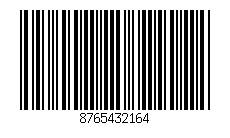
Developed by Intermec in 1977, Code 11 is similar to Code 2 of 5 Matrix and is primarily used in telecommunications. The symbol can encode any length string consisting of the digits 0-9 and the dash character (-). One modulo-11 check digit is calculated.
Example
The following will render a Code 11 symbol encoding 8765432164:
createStream({
symbology: SymbologyType.CODE11
}, '8765432164')
Code 2 of 5
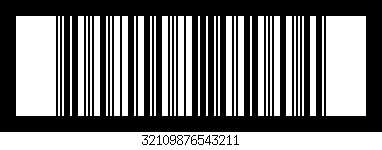
Code 2 of 5 is a family of one-dimensional symbols, 8 of which are supported. Note that the names given to these standards alters from one source to another so you should take care to ensure that you have the right barcode type before using these standards.
Standard Code 2 of 5
Also known as Code 2 of 5 Matrix, this symbology is a self-checking code used in industrial applications and photo development. Standard Code 2 of 5 will encode any length numeric input (digits 0-9).
Example
The following will render a standard Code 2 of 5 symbol encoding 32109876543211:
createStream({
symbology: SymbologyType.C25IATA,
borderWidth: 6
}, '32109876543211')
IATA Code 2 of 5
Used for baggage handling in the air-transport industry by the International Air Transport Agency, this self-checking code will encode any length numeric input (digits 0-9) and does not include a check digit.
Industrial Code 2 of 5
Industrial Code 2 of 5 can encode any length numeric input (digits 0-9) and does not include a check digit.
Interleaved Code 2 of 5
This self-checking symbology encodes pairs of numbers, and so can only encode an even number of digits (0-9). If an odd number of digits is entered a leading zero is automatically added. No check digit is added.
Code 2 of 5 Data Logic
Data Logic does not include a check digit and can encode any length numeric input (digits 0-9).
ITF-14
ITF-14, also known as UPC Shipping Container symbol or Case Code, is based on Interleaved Code 2 of 5 and requires a 13 digit numeric input (digits 0-9). One modulo-10 check digit is automatically added.
Deutsche Post Leitcode
Leitcode is based on Interleaved Code 2 of 5 and is used by Deutsche Post for mailing purposes. Leitcode requires a 13-digit numerical input and includes a check digit.
Deutsche Post Identcode
Identcode is based on Interleaved Code 2 of 5 and is used by Deutsche Post for mailing purposes. Identcode requires an 11-digit numerical input and includes a check digit.
Universal Product Code (EN 797)
UPC Version A
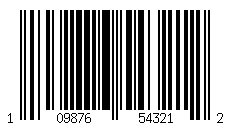
UPC-A is used in the United States for retail applications. The symbol requires an 11 digit article number. The check digit is automatically computed. In addition EAN-2 and EAN-5 add-on symbols can be added using the + character.
Example
createStream({
symbology: SymbologyType.UPCA,
encoding: EncodingMode.UNICODE_MODE,
primary: '331234567890'
}, '72527270270+12345')
Note
If your input data already includes the check digit symbology 35 can be used which takes a 12 digit input and validates the check digit before EncodingMode.
UPC Version E
UPC-E is a zero-compressed version of UPC-A developed for smaller packages.
The code requires a 6 digit article number (digits 0-9). The check digit is automatically computed. EAN-2 and EAN-5 add-on symbols can be added using the + character as with UPC-A.
Number System 1 Example
This library also supports Number System 1 encoding by entering a 7-digit article number stating with the digit 1.
createStream({
symbology: SymbologyType.UPCE
}, '1123456')
Note
If your input data already includes the check digit symbology 38 can be used which takes a 7 or 8 digit input and validates the check digit before EncodingMode.
European Article Number (EN 797)
The International Article Number is a standard describing a barcode symbology and numbering system used in global trade to identify a specific retail product type, in a specific packaging configuration, from a specific manufacturer.
EAN-2, EAN-5, EAN-8 and EAN-13
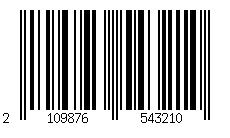
The EAN system is used in retail across Europe and includes standards for EAN-2 and EAN-5 add-on codes, EAN-8 and EAN-13 which encode 2, 5, 7 or 12 digit numbers respectively.
EAN-2 and EAN-5 add-on symbols can be added using the + symbol as with UPC symbols.
Note
The symbology to use is automatically selected depending on the length of the input data.
EAN-5 Example
The following example will encode a standalone EAN-5:
createStream({
symbology: SymbologyType.EANX
}, '54321')
EAN-8 with EAN-5 Add-on Example
The following example will encode an EAN-8 symbol with an EAN-5 add-on:
createStream({
symbology: Symbology.SymbologyType.EANX
}, '7432365+54321')
Note
All of the EAN symbols include check digits which is automatically added.
Tip
If you are encoding an EAN-8 or EAN-13 symbol and your data already includes the check digit then you can use symbology 14 which takes an 8 or 13 digit input and validates the check digit before EncodingMode.
SBN, ISBN and ISBN-13
EAN-13 symbols (also known as bookland EAN-13) can also be produced from 9-digit SBN, 10-digit ISBN or 13-digit ISBN-13 data.
EAN-2 and EAN-5 add-on symbols can also be added using the + symbol, as with UPC symbols.
Important
The relevant check digit must be present in the input data and will be verified before the symbol is generated.
Plessey
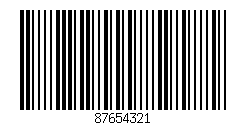
Also known as Plessey Code, this symbology was developed by the Plessey Company Ltd. in the UK. The symbol can encode any length data consisting of digits (0-9) or letters AF and includes a CRC check digit.
MSI Plessey
Based on Plessey and developed by MSE Data Corporation, MSI Plessey is available with a range of check digit options available by setting option2.
The table below shows the options available:
Value of option2 | Check Digits |
|---|---|
| 0 | None |
| 1 | Modulo-10 |
| 2 | Modulo-10 & Modulo-10 |
| 3 | Modulo-11 |
| 4 | Modulo-11 & Modulo-10 |
Example
The following example will create an MSI Plessey symbol with modulo-10 check digit encoding 7432365:
createStream({
symbology: SymbologyType.MSI_PLESSEY,
option2: 1
}, '7432365')
Note
Any length numeric (digits 0-9) input can be encoded.
Telepen
Telepen Alpha
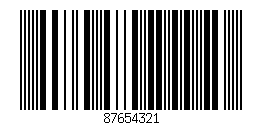
Telepen Alpha was developed by SB Electronic Systems Limited and can encode any length of ASCII text input. Telepen includes a modulo-127 check digit.
Telepen Numeric
Telepen Numeric allows compression of numeric data into a Telepen symbol.
Data can consist of pairs of numbers or pairs consisting of a numerical digit followed an X character. For example 466333 and 466X33 are valid codes, whereas 46X333 is not (the digit pair X3 is not valid). Telepen Numeric includes a modulo-127 check digit which is automatically added.
Code 39
Standard Code 39 (ISO 16388)
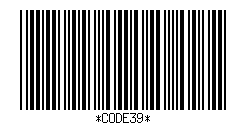
Standard Code 39 was developed in 1974 by Intermec. Input data can be of any length and can include the characters 0-9, A-Z, dash (-), full stop (.), space (), asterisk (*), dollar ($), slash (/), plus (+) and percent (%).
Example
The following example will create a Code 39 symbol with modulo-10 check digit encoding CODE39:
createStream({
symbology: SymbologyType.CODE39
}, 'CODE39')
Note
The standard does not require a check digit, but a modulo-43 check digit can be added via option2.
Extended Code 39
Also known as Code 39e and Code39+, this symbology expands on Standard Code 39 to provide support to the full ASCII character set.
Note
The standard does not require a check digit, but a modulo-43 check digit can be added via option2.
Code 93
A variation of Extended Code 39, Code 93 also supports full ASCII text. Two check digits are automatically added.
PZN
PZN is a Code 39 based symbology used by the pharmaceutical industry in Germany. PZN encodes a six-digit number to which a modulo-10 check digit will be added.
LOGMARS
LOGMARS (Logistics Applications of Automated Marking and Reading Symbols) is a variation of the Code 39 symbology used by the United States Department of Defense. LOGMARS encodes the same character set as Standard Code 39 and adds a modulo-43 check digit.
Code 32
A variation of Code 39 used by the Italian Ministry of Health ("Ministero della Sanità") for encoding identifiers on pharmaceutical products. Used for encoding identifiers on pharmaceutical products. A check digit is automatically added.
Important
This symbology requires a numeric input up to 8 digits in length.
HIBC Code 39
This option adds a leading + character and a trailing modulo-49 check digit to a standard Code 39 symbol as required by the Health Industry Barcode standards.
Vehicle Identification Number
This option includes a verification stage for vehicle identification numbers used in North America which include a check digit.
Note
For European vehicle identification numbers, use Standard Code 39 instead.
Codabar (EN 798)
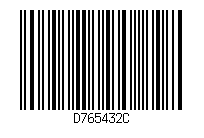
Also known as NW-7, Monarch, ABC Codabar, USD-4, Ames Code, or Code 27, this symbology was developed in 1972 by Monarch Marketing Systems for retail purposes. The American Blood Commission adopted Codabar in 1977 as the standard symbology for blood identification.
Codabar can encode any length string starting and ending with the letters A-D and containing between these letters the numbers 0-9, dash (-), dollar ($), colon (:), slash (/), full stop (.) or plus sign (+).
Note
No check digit is generated.
Pharmacode
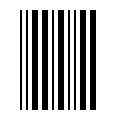
Developed by Laetus, Pharmacode is used for the identification of pharmaceuticals. The symbology is able to encode whole numbers between 3 and 131070.
Example
The following example will create a Pharmacode symbol with modulo-10 check digit encoding 131070:
createStream({
symbology: SymbologyType.PHARMA
}, '131070')
Code 128
Standard Code 128 (ISO 15417)
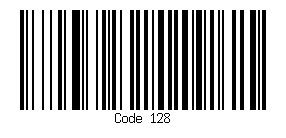
One of the most ubiquitous one-dimensional barcode symbologies, Code 128 was developed in 1981 by Computer Identics. This symbology supports full ASCII text and uses a three-mode system to compress the data into a smaller symbol.
This library automatically switches between modes and adds a modulo-103 check digit.
Note
This library supports the encoding of Latin-1 characters in Code 128 symbols.
Code 128 Subset B
It is sometimes advantageous to stop Code 128 from using subset mode C which compresses numerical data. The CODE128B symbology suppresses mode C in favour of mode B.
GS1-128
Also known as UCC/EAN-128, this variation of Code 128 is defined by the GS1 General Specifications.
Example
The following is an example of a valid GS1-128 input:
createStream({
symbology: Symbology.SymbologyType.EAN128
}, '[01]98898765432106[3202]012345[15]991231')
Important
- AIs should be encased in square brackets (
[...]) in the input data. This will be converted to (rounded brackets) before it is included in the human readable text attached to the symbol. - GTIN data (AI
01) should also include the check digit data. - Fixed length data should be entered at the appropriate length for correct EncodingMode.
- GS1-128 does not support extended ASCII characters. Check digits for GTIN data (AI
01) are not generated and must be included in the input data.
EAN-14
A shorter version of GS1-128 which encodes GTIN data only. A 13 digit number is required. The GTIN check digit and AI (01) are automatically added.
NVE-18
The Nummer der Versandeinheit standard is a variation of Code 128 that includes both modulo-10 and modulo-103 check digits.
Note
NVE-18 requires a 17 digit numerical input and check digits are automatically added.
HIBC Code 128
This option adds a leading + character and a trailing modulo-49 check digit to a standard Code 128 symbol as required by the Health Industry Barcode standards.
GS1 DataBar (ISO 24724)
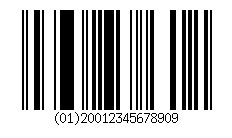
Also known as RSS (Reduced Spaced symbology), these symbols are due to replace GS1-128 symbols in accordance with the GS1 General Specifications.
To set a GS1 DataBar symbol to print with a 2D component (as specified in ISO 24723), set option1 to 2.
Tip
See Composite Symbols to find out how to generate DataBar symbols with 2D components.
DataBar-14 and DataBar-14 Truncated
Also known as RSS-14, this standard encodes a 13-digit item code. A check digit and application identifier of (01) are automatically added.
Tip
To produce a truncated symbol set the symbol height to a value between 32 and 13.
Important
Normal DataBar-14 symbols should have a height of 33 or greater.
DataBar Limited
Also known as RSS Limited this standard encodes a 13 digit item code and can be used in the same way as DataBar-14. DataBar Limited, however, is limited to data starting with digits 0 and 1 (i.e., numbers in the range of 0 to 1999999999999).
Note
As with DataBar-14, a check digit and application identifier of (01) are automatically added.
DataBar Expanded
Also known as RSS Expanded, this is a variable length symbology capable of encoding data from a number of AIs in a single symbol.
Important
- AIs should be encased in square brackets (
[...]) in the input data. This will be converted to (rounded brackets) before it is included in the human readable text attached to the symbol. - GTIN data (AI
01) should also include the check digit data. - Fixed length data should be entered at the appropriate length for correct EncodingMode.
Example
createStream({
symbology: Symbology.SymbologyType.RSS_EXP
}, '[01]98898765432106[3202]012345[15]991231')
Korea Post Barcode
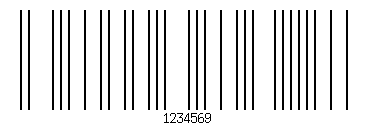
The Korean Postal Barcode is used to encode a six-digit number and includes one check digit.
Channel Code
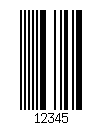
A highly-compressed symbol for numeric data. The number of channels in the symbol can be between 3 and 8 by setting the value of option2. It can also be determined by the length of the input data (e.g., a three-character input string generates a four-channel code by default).
The maximum values permitted depend on the number of channels used:
| Channels | Minimum Value | Maximum Value |
|---|---|---|
| 3 | 00 | 26 |
| 4 | 000 | 292 |
| 5 | 0000 | 3493 |
| 6 | 00000 | 44072 |
| 7 | 000000 | 576688 |
| 8 | 0000000 | 7742862 |
Example
The following example renders a 5-channel Channel Code symbol:
createStream({
symbology: SymbologyType.CHANNEL,
option2: 6
}, '12345')
Note
Channel codes 7 and 8 require a processor-intensive algorithm to generate and so response times when generating these codes will be relatively slow.